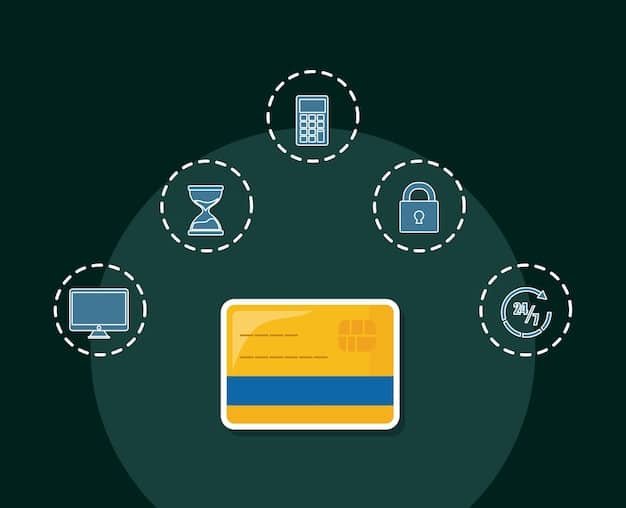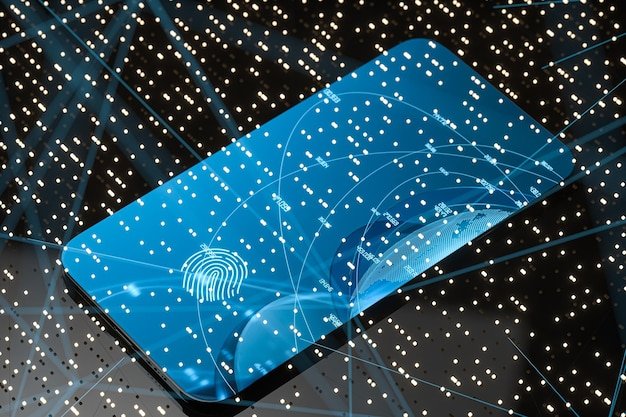Biometric Credit Cards in the US: Balancing Security and Privacy

The rise of biometric credit cards in the US marks a significant shift in payment technology, offering enhanced security through fingerprint or facial recognition while raising important questions about data privacy and potential risks.
The introduction of biometric credit cards in the US has sparked considerable interest and debate. These cards promise enhanced security features, utilizing fingerprint or facial recognition to authorize transactions. However, this technological advancement also brings forth concerns about privacy and the potential misuse of biometric data.
Understanding Biometric Credit Cards
Biometric credit cards are a new generation of payment cards that incorporate biometric technology, typically fingerprint scanners, to authenticate transactions. This method aims to provide a more secure and convenient way for consumers to make purchases.
How Biometric Credit Cards Work
Unlike traditional credit cards that rely on a signature or PIN for verification, biometric cards require the cardholder to scan their fingerprint on a small sensor embedded in the card. This ensures that only the authorized user can complete the transaction.
Benefits of Biometric Authentication
- Enhanced Security: Reduces the risk of fraud and unauthorized use.
- Convenience: Eliminates the need to remember PINs or carry multiple cards.
- Improved Hygiene: Offers a contactless authentication method, reducing physical contact.
The adoption of biometric technology in credit cards represents a significant step forward in securing financial transactions. By using unique biological traits for authentication, these cards offer a higher level of protection against fraud compared to traditional methods.

The Security Advantages of Biometric Cards
One of the primary drivers behind the adoption of biometric credit cards is the promise of enhanced security. Traditional credit cards are vulnerable to various forms of fraud, but biometric cards offer a more robust defense.
Reducing Fraudulent Transactions
Biometric authentication makes it significantly harder for criminals to use stolen or counterfeit cards. The fingerprint requirement adds an extra layer of security that is difficult to bypass.
Protecting Against Skimming and Cloning
Skimming and cloning are common methods used by fraudsters to steal credit card information. Biometric cards address this issue by ensuring that the card cannot be used without the authorized user’s fingerprint.
Real-World Examples of Security Breaches
- Data breaches at major retailers exposing millions of credit card numbers.
- Instances of ATM skimming leading to unauthorized withdrawals.
- Online fraud where stolen credit card information is used to make purchases.
The security advantages of biometric credit cards are clear, offering a significant improvement over traditional methods. By requiring biometric authentication, these cards can help reduce fraud and protect consumers from financial losses.
Privacy Concerns and Data Protection
While biometric credit cards offer numerous security benefits, they also raise important questions about privacy and data protection. Consumers are increasingly concerned about how their personal information is collected, stored, and used.
How Biometric Data is Stored
The way biometric data is stored is crucial for protecting privacy. Most biometric credit cards store fingerprint templates on the card itself rather than transmitting them to a central database.
Potential Risks of Data Breaches
Despite the localized storage of biometric data, there is still a risk of data breaches. If a card is compromised, the fingerprint template could potentially be accessed by unauthorized individuals.
Regulations and Compliance
- The California Consumer Privacy Act (CCPA)
- The General Data Protection Regulation (GDPR)
- Industry standards like PCI DSS
Addressing privacy concerns requires a multi-faceted approach, including robust data protection measures, transparent privacy policies, and strict regulatory oversight. By prioritizing privacy and security, biometric credit card providers can build trust with consumers and ensure the responsible use of this technology.

Consumer Adoption and Challenges
The widespread adoption of biometric credit cards in the US depends on several factors, including consumer acceptance, technological advancements, and regulatory support. Overcoming these challenges is essential for realizing the full potential of this technology.
Factors Influencing Adoption Rates
Consumer trust in biometric technology is a key factor. Many people are wary of sharing their biometric data due to concerns about privacy and security.
Technological Limitations
Current biometric technology is not perfect. Fingerprint scanners can be unreliable in certain conditions, such as when fingers are wet or dirty.
Addressing Consumer Concerns
- Education: Providing clear and accurate information about how biometric credit cards work.
- Transparency: Being open about how biometric data is collected, stored, and used.
- Security Measures: Implementing robust security measures to protect biometric data from unauthorized access.
Addressing consumer adoption and challenges requires a collaborative effort between technology providers, financial institutions, and regulatory bodies. By working together, these stakeholders can build a framework that promotes the responsible and secure use of biometric credit cards.
The Future of Biometric Payment Technology
Biometric credit cards are just one aspect of a broader trend towards biometric payment technology. As technology continues to evolve, we can expect to see even more innovative ways to use biometrics for authentication and security.
Emerging Trends in Biometric Authentication
Facial recognition, voice recognition, and iris scanning are all emerging as potential alternatives to fingerprint scanning for biometric authentication.
Integration with Mobile Payments
Biometric authentication is already widely used in mobile payment systems like Apple Pay and Google Pay. This trend is likely to continue as more consumers adopt mobile payment methods.
The Role of Artificial Intelligence (AI)
AI can play a significant role in enhancing the accuracy and security of biometric authentication systems. AI algorithms can be used to analyze biometric data and detect fraudulent activity.
The future of biometric payment technology is promising, with the potential to transform the way we conduct financial transactions. By embracing innovation and addressing challenges, we can create a more secure and convenient payment ecosystem for consumers.
Balancing Security and Privacy in the Biometric Era
The rise of biometric credit cards in the US highlights the ongoing tension between security and privacy. Finding the right balance between these two priorities is essential for fostering trust and ensuring the responsible use of biometric technology.
Implementing Strong Data Protection Measures
Protecting biometric data from unauthorized access is paramount. This requires implementing robust security measures, such as encryption, access controls, and regular security audits.
Ensuring Transparency and Control
Consumers should have clear and transparent information about how their biometric data is collected, stored, and used. They should also have control over their data, including the ability to access, correct, and delete it.
Promoting Ethical Guidelines
- Data Minimization: Collecting only the biometric data that is necessary for authentication.
- Purpose Limitation: Using biometric data only for the purpose for which it was collected.
- Accountability: Holding organizations accountable for protecting biometric data.
Balancing security and privacy in the biometric era requires a commitment to strong data protection measures, transparency, and ethical guidelines. By prioritizing these principles, we can harness the benefits of biometric technology while safeguarding individual rights and freedoms.
| Key Aspect | Brief Description |
|---|---|
| 🔐 Enhanced Security | Uses fingerprint or facial recognition, reducing fraud. |
| 🤔 Privacy Concerns | Raises questions about data storage and potential breaches. |
| 📈 Adoption Challenges | Consumer trust and tech reliability are key hurdles. |
| 🔮 Future Trends | Integration with mobile payments and AI for better accuracy. |
Frequently Asked Questions
▼
▼
▼
▼
▼
Conclusion
In conclusion, **the rise of biometric credit cards in the US** represents a significant advancement in payment technology, offering enhanced security and convenience. However, it is crucial to address the privacy concerns and challenges associated with biometric data. By implementing strong data protection measures and fostering transparency, we can harness the benefits of biometric credit cards while safeguarding individual rights and freedoms, ensuring a secure and trustworthy payment ecosystem.





